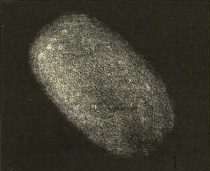 Coma of 5D/Brorsen, as it appeared on May 14, 1868, drawn by Karl Christian Bruhns Coma of 5D/Brorsen, as it appeared on May 14, 1868, drawn by Karl Christian Bruhns | |
| Discovery | |
|---|---|
| Discovered by | Theodor Brorsen |
| Discovery date | 26 February 1846 |
| Designations | |
| Alternative designations | 1846 III; P/1846 D2; 1857 II; P/1857 F1; 1868 I; 1873 VI; 1879 I |
| Orbital characteristics | |
| Epoch | March 31, 1879 |
| Aphelion | 5.610 AU |
| Perihelion | 0.5898 AU |
| Semi-major axis | 3.100 AU |
| Eccentricity | 0.8098 |
| Orbital period | 5.461 a |
| Inclination | 29.382° |
| Last perihelion | March 31, 1879 |
| Next perihelion | Lost since 1879 |
| TJupiter | 2.467 |
5D/Brorsen (also known as Brorsen's Comet or Comet Brorsen) was a periodic Jupiter-family comet discovered on February 26, 1846, by Danish astronomer Theodor Brorsen. The comet was last seen in 1879 and is now considered lost.
Observational history
The comet was discovered on February 26, 1846, by Danish astronomer Theodor Brorsen. The perihelion of 5D/Brorsen was February 25, just a day before its discovery, and it passed closest to Earth on March 27, at a distance of 0.52 AU. As a result of this close encounter to Earth the comet's coma diameter increased. Johann Friedrich Julius Schmidt estimated it as 3 to 4 arcminutes across on March 9, and 8 to 10 arcminutes across on the 22nd of that same month. On April 22, it was about 20 degrees from the north celestial pole. By the end of this first apparition the orbital period was calculated as 5.5 years. It was discovered that a close approach to Jupiter in 1842 put it in its discovery orbit.
The comet's 5.5-year period would mean that apparitions would alternate between good and poor. As expected, the comet was missed in its 1851 apparition, when it only came as close as 1.5 AU to Earth. The comet's orbit was still relatively uncertain, made worse by its approach to Jupiter in 1854. Karl Christian Bruhns found a comet on 18 March 1857. Soon an orbit was computed and it was found to be 5D/Brorsen, although predictions were three months off. The comet was followed until June 1857, and the orbit was then well established. Observers reported that the comet had a bright, almost star-like nucleus.
The comet was missed in 1862, and the next recovery was in 1868. A close approach to Jupiter shortened the period enough to make the comet visible in 1873. A very favorable apparition followed in 1879, allowing the comet to be observed for the longest time to date – four months. The comet was missed in 1884, due to observing circumstances, but was also missed in 1890, a favorable apparition. The next favorable apparition occurred in 1901, but searches did not locate the comet.
The next serious search was started by Brian G. Marsden in 1963, who believed the comet had faded out of existence, but computed the orbit for a very favorable 1973 apparition. Japanese observers made intensive searches for the comet, but nothing turned up. This failure to locate the comet, in conjunction with earlier attempts, lead Marsden to conclude that the comet was lost.
Zdenek Sekanina suggested that the comet underwent a change in the rotation axis of the nucleus in mid 19th century, resulting to non-gravitational changes in the orbit, while also mentioned that there are some evidence that the comet may have disintegrating. These evidence are the accounts of the large expansion of the coma after perihelion at the 1868 and 1879 apparitions, the presence of condensations in the inner coma during the 1857 and 1868 apparitions and the account by Johann Friedrich Julius Schmidt that on 20 May 1879 the comet was very faint and lacked a nucleus.
References
- ^ Kronk, Gary W. (2001–2005). "5D/Brorsen". Retrieved 26 December 2005. (Cometography Home Page)
- Gould, B. A. (April 1857). "Second comet of 1857". The Astronomical Journal. 5: 48. Bibcode:1857AJ......5...48G. doi:10.1086/100581.
- ^ Sekanina, Z. (April 1984). "Disappearance and disintegration of comets". Icarus. 58 (1): 81–100. Bibcode:1984Icar...58...81S. doi:10.1016/0019-1035(84)90099-X.
- Orbital data taken from this preprint: Neslusan, Lubos: "The identification of asteroid 1996 SK with the extinct nucleus of comet 5D/Brorsen", Memorie della Società Astronomica Italiana, Spec. Vol.: Proc. Internat. Conf. held at Palermo, Italy, June 11–16, 2001 (Postscript version)
External links
| Numbered comets | ||
|---|---|---|
| Previous 4P/Faye |
5D/Brorsen | Next 6P/d'Arrest |

